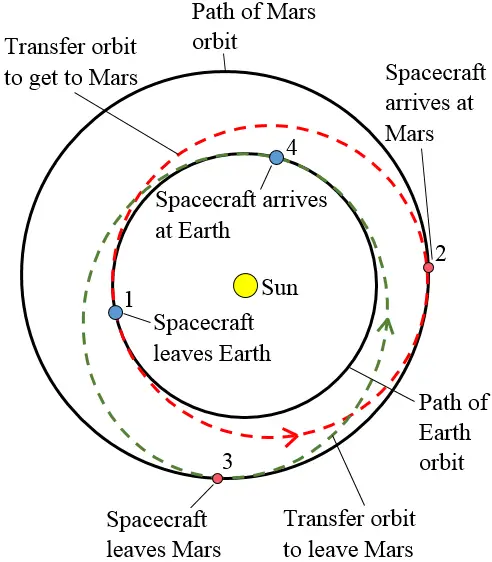How Long Does It Take To Get To Mars?
The question, how long does it take to get to mars, is not quite as simple as figuring out how long it takes, say, to drive somewhere. When a spacecraft leaves Earth to travel to Mars, there needs to be a precise trajectory calculated so that the spacecraft ends up not where Mars is at the present time, but where its going to be. Both the Earth, Mars, and all the other bodies in the solar system orbit around the sun in well-known paths. They are always in motion, and to arrive at a destination that is in motion you need to know where its going to be and when. Therefore, when a spacecraft leaves Earth it can be programmed with the exact information it needs to arrive at precisely its destination, whether that is Mars or somewhere else in the solar system. The figure below illustrates how a spacecraft can travel from Earth to Mars, and then from Mars back to Earth.
The transfer orbits shown above are elliptical in shape and are called Hohmann transfer orbits, named after Walter Hohmann, a German engineer who described them in his 1925 book Die Erreichbarkeit der Himmelskörper, which means "The Attainability of Celestial Bodies".
Hohmann transfer orbits are significant because they result in the least amount of rocket fuel burned by the spacecraft in order to go from the Earth orbit to the Mars orbit, and vice-versa. This means that the least amount of energy is used by the spacecraft's rocket engines. The spacecraft needs to increase its speed when going from the Earth orbit to the Mars orbit (to reach Mars), and then decrease its speed to go from the Mars orbit to the Earth orbit (to reach Earth). The increase or decrease in speed is accomplished by burning rocket fuel to accelerate the spacecraft, or decelerate the spacecraft, respectively.
In the diagram shown above, both Earth and Mars orbit around the Sun in the counterclockwise direction. Note that only half the transfer orbits are travelled by the spacecraft, from 1 to 2 (when going from Earth to Mars), and from 3 to 4 (when going from Mars to Earth).
With current rocket technology, it would typically take about 9 months to go from Earth to Mars (1 to 2), and about 9 months to go from Mars to Earth (3 to 4) – for the case where we want to send people there and back. To achieve this ideal travel time, the trip from Earth to Mars, and Mars to Earth, must be timed correctly. There is only one launch window available every 26 months to do this using the Hohmann transfer orbit, for which the relative position of Mars and Earth is ideal, resulting in the shortest travel time. Missing the launch window means that a trip to Mars and back would take longer. For sending people to Mars, the ideal round trip would consist of: 9 months to get there, spending 3 months there (in order to wait for the next suitable launch window), and then 9 months to get back. With the technology of the rockets available now, there is no way to shorten the travel time so that it's much less than this. Perhaps faster rockets will be available in the near future and this will then become possible.
References
https://image.gsfc.nasa.gov/poetry/venus/q2811.html
https://pages.uoregon.edu/soper/Orbits/marsorbit.html
http://alicesastroinfo.com/2010/02/which-way-to-mars/
https://nssdc.gsfc.nasa.gov/planetary/mars/marsprof.html
https://solarsystem.nasa.gov/basics/chapter4-1/
Return to Miscellaneous Physics page
Return to Real World Physics Problems home page
Free Newsletter
Subscribe to my free newsletter below. In it I explore physics ideas that seem like science fiction but could become reality in the distant future. I develop these ideas with the help of AI. I will send it out a few times a month.